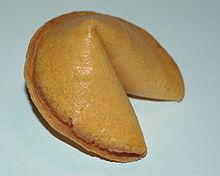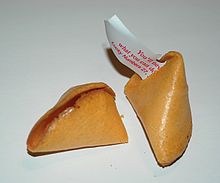fortune cookie
A fortune cookie is a crispy sweet pastry with a strip of paper with a motto or an interpretation of the future inside. Fortune cookies are particularly common in the United States and Europe , where they are served in Chinese restaurants after a meal. However, the fortune cookies do not originally come from China, but from Japan . In their current form, they first appeared on the American west coast at the beginning of the 20th century. The sayings contained in the biscuits today have a number of different backgrounds and are no longer based mainly on Far Eastern philosophy.
history
Fortune cookies are mentioned in Japanese art and literature decades before they were introduced on the American west coast by immigrants from Asia. Among other things, the work Haru no Wakakusa by the Japanese writer Tamenaga Shunsui, who died in 1844 , reports on a tsujiura senbei , a fortune cookie. In the 1878 book, Moshiogusa Kinsei Kidan of Shinoda Kensa also tsujiura senbei mentioned, accompanied by an illustration showing an apprentice in the production of baked goods. The fortune cookie in its current form, which differs mainly in taste from the Japanese tsujiura senbei , was introduced to California by Asian immigrants in the early 20th century. However, the exact history of their origin and distribution is still unclear. Several families, most of them of Japanese origin, claim the invention of the biscuit.
According to the most widespread theory, the idea of making cookies and handing them out after dinner came from Japanese immigrant Makato Hagiwara, who ran a Japanese tea garden in Golden Gate Park in San Francisco . Sometime between 1907 and 1914, he is said to have started handing out fortune cookies - at the time called fortune tea cookies - with tea. However, the production of the cookies was not taken over by Hagiwara itself, but by the Japanese bakery Benkyodo .
Another theory suggests that fortune cookies originated from Chinese entrepreneur David Jung, owner of the Hong Kong Noodle Factory in Los Angeles. Jung is said to have started producing fortune cookies around 1918, which would probably make him the first manufacturer of fortune cookies of Chinese origin. However, his claim to the idea of the biscuits is now being questioned for several reasons. Since Jung's company was located in a neighborhood that was also home to Japanese immigrants, it is possible that he came into contact with the Japanese fortune cookies before.
The fact that the fortune cookie is now mistakenly viewed as a Chinese dish can be attributed to two main reasons. Numerous Japanese immigrants ran restaurants that served Americanized Chinese cuisine in the 1920s and 1930s. In addition, Chinese restaurants picked up the biscuits early on and thereby contributed significantly to spreading them among the American population. The fortune cookie first established itself as a local custom in San Francisco, and in the decades that followed, it spread across the United States from the west coast. During the Second World War , people of Japanese descent who lived on the American west coast were interned in so-called war relocation centers . Several Japanese bakeries that had baked fortune cookies before the World War had to close as a result. Presumably companies of Chinese-born owners took over the production of the fortune cookies during this time.
The fortune cookies were brought to Europe by the engineer Emil Janik from Heidenrod , who got to know fortune cookies while on vacation in a Chinese restaurant in San Francisco. His company Janeco International GmbH in Heidenrod has been producing the biscuits since 1988; it now delivers almost 25 million fortune cookies every year all over the world. The first machines for production came from America. However, these did not meet the German standard for the production of food. Emil Janik then converted the production facility according to German guidelines and then patented his further developments.
The cookies were first exported to China in the 1990s, where they had been completely unknown until then.
Origin of the idea
Both of the entrepreneurs mentioned above, Hagiwara and Jung, could have picked up on old stories from baked-in notes of their home cultures. Tales of baked-in scripts are known from almost every culture and have nothing typically Chinese about them.
It is said that moon cakes contributed to the invention of fortune cookies. These were served on many occasions early in China's history . They were flavored with a paste made from ingredients from the lotus plant . The Legend of had Chinese resistance fighters during the occupation of China by the Mongols in the 13th and 14th centuries of our era, communication problems, and these resistance groups have made the switch due to the size of the country and the sharp controls the exchange of messages that in such a moon cake were hidden. Legend has it that Chu Yuan Chang, a patriotic revolutionary, disguised himself as a Taoist priest and traveled the country to distribute moon cakes in the occupied cities, which was also used for anti-Mongol propaganda.
Manufacturing
Fortune cookies have been machine-made in the USA since 1964. Today they are manufactured fully industrially in large numbers and consist of wafer dough , whereby a circular dough piece is heated and bent into the shape of a boat by machines. Before bending, a narrow strip of paper is inserted; after bending, the dough, which contains a lot of sugar, hardens quickly. Fortune cookies made in this way take on humidity and are therefore individually sealed in foil. As a rule, they are sold in bulk packs to restaurants or dealers who can often order different sets of texts, including “wisdom”, “fortune telling”, seasonal texts or texts for certain occasions, funny or funny content or mixed assortments.
The sayings are written partly by freelance copywriters and partly by employees of the manufacturing companies. The American market leader Wonton Food from the New York City area had around 15,000 different sayings in its database in 2013 with a production of 4.5 to 5 million fortune cookies per day; at the competitor Yang's Fortunes in San Francisco there were 5,000 sayings for around 4 million fortune cookies a day. In both cases, high-ranking employees of the companies themselves worked as copywriters. Here served horoscopes , collections of quotations and authentic Chinese proverbs as inspiration.
The saying databases are updated regularly, new sayings are added and old ones that no longer seem appropriate are sorted out. "Lucky numbers" are generated by computers. In 2005, five out of six winning numbers in an American lottery happened to match the lucky numbers on fortune cookies, which resulted in the number of winners multiplying.
In Germany, fortune cookies have been produced by the company "sweet & lucky" in Gondelsheim in Baden since 2003. Customers can either have the sayings baked at random from a collection of around 700–1000 sayings or they can create their own sayings. The film can be individually printed. The company is certified according to the International Food Standard (IFS).
Web links
Individual evidence
- ↑ Angela Köckritz: China: 德国, 你好! In: Die Zeit , January 17, 2008 No. 04. Accessed on January 12, 2012. "Incidentally, there is no fortune cookie in China"
- ↑ a b c d Jennifer 8. Lee: Solving a Riddle Wrapped in a Mystery Inside a Cookie In: New York Times , January 16, 2008. Retrieved January 12, 2012.
- ↑ a b Jennifer 8. Lee: Fortune Cookies are really from Japan. ( Memento of July 25, 2011 in the Internet Archive ), January 16, 2008. Retrieved January 12, 2012.
- ↑ Leslie Lieber: The Inside Story of Chinese Fortune Cookies ( Memento from February 3, 2011 in the Internet Archive ) (PDF; 418 kB) In: Los Angeles Times , June 7, 1959. Retrieved January 13, 2012. “'It may surprise you to learn 'said the Chinese Nationalist Republic Emissary,' that fortune cookies are completely unknown in China […] It was the Japanese immigrants out on the West Coast who started the whole idea in the US […] '"
- ↑ Jennie Yabroff: Lo Mein Street, USA ( January 16, 2012 memento in the Internet Archive ) In: Newsweek , March 1, 2008. Retrieved January 14, 2012. "Fortune cookies were invented in Japan."
- ↑ Jennifer 8. Lee: The last word: Why Confucius quit the cookie business In: The Week , March 13, 2008. Retrieved January 14, 2012.
- ^ A b Gary T. Ono: Japanese American Fortune Cookie: A Taste of Fame or Fortune Japanese American National Museum , November 1, 2007. Retrieved January 12, 2012.
- ↑ 藻 汐 草 近世 奇談 , on the National Diet Library . Retrieved January 13, 2012.
- ↑ a b c d Jenny 8. Lee: How did Japanese fortune cookies end up in Chinese restaurants? ( Memento of November 16, 2009 in the Internet Archive ), January 16, 2008. Retrieved January 12, 2012.
- ↑ Jennifer 8. Lee, Solving a Riddle Wrapped in a Mystery Inside a Cookie In: New York Times , January 16, 2008. Retrieved January 13, 2012. “Ms. Nakamachi speculates that Chinese-owned manufacturers began to take over fortune cookie production during World War II, when Japanese bakeries all over the West Coast closed as Japanese-Americans were rounded up and sent to internment camps. "
- ^ A b Steve Harvey: LA, SF won't like cookie's message In: Los Angeles Times , June 8, 2011. Retrieved January 14, 2012.
- ↑ Fortune cookies in Germany. Accessed November 1, 2019 (German).
- ↑ Happiness comes from Heidenrod . In: IHK Wiesbaden . ( ihk-wiesbaden.de [accessed April 30, 2018]).
- ↑ Karina Martinez-Carter: How do fortune cookie messages get written? , theweek.com on May 15, 2013, viewed February 3, 2018
- ↑ Jeremy Olshan: Cookie Master , newyorker.com June 6, 2005, viewed February 3, 2018
- ↑ sweet & lucky: Fortune cookies from Gondelsheim , accessed on November 1, 2019


